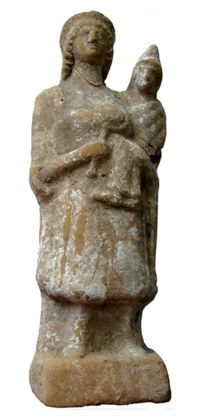Female robed figure with child
|
Female robed figure with child, Inv. T I-25 Front side from the mould. Back not finished, flat rounded, smoothed, with large trapezoidal kilning hole. Light brown (7.5YR 7/5) clay. Abundant white engobe. Traces of dark blue paint in the child's hair and cap. Provenance: Acquired by Bruno Sauer from the Margaritis Collection. State of preservation: Complete, assembled from several fragments. Head of the woman and upper part of the child glued on. Small fragment inserted above the woman's left hand. Bumping on the polos, the child's cap and the woman's right shoulder. Dimensions: H: 25,0 cm; W: 9,2 cm; D: 6,7 cm References: M. Recke, Antike Kunst aus der Sammlung der Justus-Liebig-Universität (Gießen 2010) 22-23 and 27, no. 45; id., Neues aus der Antikensammlung – Jahresbericht 2010-2011, 5. |
Commentary: Without the fullness characteristic of early age, the child, whose legs appear strikingly long, looks like a small adult. Due to the broad stance and the angular outline of the woman, the whole group appears clumsy and ponderous. Close parallels originating from Boeotia can be found in Hanover and Munich [1]. The latter is distinguished by the sharpness of the contours and the precision of the details. The height is three cm more than that of the Giessen example and the woman's polos is larger. In contrast, the outlines of the only slightly smaller comparison piece in Hanover seem a little flat. Without a visual inspection, it is impossible to say whether the child there is wearing a round cap or whether his head is uncovered. Yet, they are so similar that the three pieces probably depend on the same matrix.
Despite the different weighting of the legs, the woman's straight upright body does not reveal the slightest ponderation, a characteristic of the early classical period, as does the pronounced lower face in contrast to the insignificant forehead area.
Judging by the tone colour, the group probably originated in Boeotia; her 'four-haired' figure would be well compatible with this.
Determination: Mid 5th century BC; Boeotia.
[1] U. Liepmann, Griechische Terrakotten Bronzen Skulpturen. Kestner-Museum (Hannover 1975) 18-19 and 59-60, fig. T 42; F. W. Hamdorf, Die figürlichen Terrakotten der staatlichen Antikensammlung (München 2014) 182 fig. D 84.




